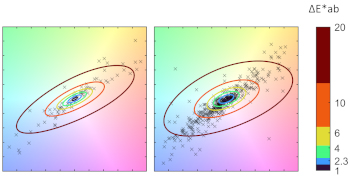References
1AndersonR. R.ParrishJ. A.1981The optics of human skinJ. Investigative Dermatology77131913–910.1111/1523-1747.ep12479191
2Del BinoS.BernerdF.2013Variations in skin colour and the biological consequences of ultraviolet radiation exposureBr. J. Dermatology169334033–4010.1111/bjd.12529
3SjodingM. W.DicksonR. P.IwashynaT. J.GayS. E.ValleyT. S.2020Racial bias in pulse oximetry measurementNew England J. Med.383247724782477–810.1056/NEJMc2029240
4WongA.-K. I.CharpignonM.KimH.JosefC.De HondA. A.FojasJ. J.TabaieA.LiuX.Mireles-CabodevilaE.CarvalhoL.KamaleswaranR.2021Analysis of discrepancies between pulse oximetry and arterial oxygen saturation measurements by race and ethnicity and association with organ dysfunction and mortalityJAMA Netw. Open4e213167410.1001/jamanetworkopen.2021.31674
5OkunlolaO. E.LipnickM. S.BatchelderP. B.BernsteinM.FeinerJ. R.BicklerP. E.2022Pulse oximeter performance, racial inequity, and the work aheadRespiratory Care67252257252–710.4187/respcare.09795
6HenryN. R.HansonA. C.SchulteP. J.WarnerN. S.ManentoM. N.J. WeisterT.WarnerM. A.2022Disparities in hypoxemia detection by pulse oximetry across self-identified racial groups and associations with clinical outcomesCrit. Care Med.50204211204–1110.1097/CCM.0000000000005394
7ShiC.GoodallM.DumvilleJ.HillJ.NormanG.HamerO.CleggA.WatkinsC. L.GeorgiouG.HodkinsonA.LightbodyC. E.2022The accuracy of pulse oximetry in measuring oxygen saturation by levels of skin pigmentation: A systematic review and meta-analysisBMC Med.2026710.1186/s12916-022-02452-8
8PlaisimeM. V.2023Invited commentary: Undiagnosed and undertreated–the suffocating consequences of the use of racially biased medical devices during the covid-19 pandemicAm. J. Epidemiology192714719714–910.1093/aje/kwad019
9Al-HalawaniR.CharltonP. H.QassemM.KyriacouP. A.2023A review of the effect of skin pigmentation on pulse oximeter accuracyPhysiol. Meas.4410.1088/1361-6579/acd51a
10KhannaA. K.BeardJ.LamminmäkiS.NärväinenJ.AntakiN.YapiciH. O.2024Assessment of skin pigmentation-related bias in pulse oximetry readings among adultsJ. Clin. Monit. Comput.38113120113–2010.1007/s10877-023-01095-1
11HaoS.DempseyK.MatosJ.CoxC. E.RotembergV.GichoyaJ. W.KibbeW.HongC.WongI.
12LeebG.AuchusI.LawT.BicklerP.FeinerJ.HashiS.MonkE.IgagaE.BernsteinM.ChouY. C.HughesC.2024The performance of 11 fingertip pulse oximeters during hypoxemia in healthy human participants with varied, quantified skin pigmentEBioMedicine10210.1016/j.ebiom.2024.105051
13McCamyC. S.MarcusH.DavidsonJ. G.1976A color-rendition chartJ. App. Photogr. Eng.2959995–9
14
15
16AmaniM.FalkH.JensenO. D.VartdalG.AuneA.LindsethF.Color calibration on human skin imagesInt’l. Conf. on Computer Vision Systems2019SpringerCham211223211–2310.1007/978-3-030-34995-0_20
17AuneA.VartdalG.DiazG. J.GiermanL. M.Bergseng,H.DarjE.2023Iterative development, validation, and certification of a smartphone system to assess neonatal jaundice: Development and usability studyJMIR Pediatrics and Parenting6e4046310.2196/40463
18
19ChengW.-C.2023Color performance review (cpr): A color performance analyzer for endoscopy devicesJ. Imaging Sci. Technol.67191–910.2352/J.ImagingSci.Technol.2023.67.5.050406
20HeldrethC. M.MonkE. P.ClarkA. T.SchumannC.EyeeX.RiccoS.2024Which skin tone measures are the most inclusive? an investigation of skin tone measures for artificial intelligenceACM J. Responsible Comput.11211–2110.1145/3632120
21VerkruijsseW.BrancartA.JaffeM. B.GroenS.2024Variability of printed monk skin tone scales may cause misclassification of clinical study participants: Caveats on printingAnesthesia & Analgesia138e43e44e43–410.1213/ANE.0000000000006995
22ZengH.LuoM.2011Skin color modeling of digital photographic imagesJ. Imaging Sci. Technol.5530201130201–110.2352/J.ImagingSci.Technol.2011.55.3.030201
23XiaoK.YatesJ. M.ZardawiF.SueeprasanS.LiaoN.GillL.LiC.WuergerS.2017Characterising the variations in ethnic skin colours: A new calibrated data base for human skinSkin Research and Technology23212921–910.1111/srt.12295
24WangY.LuoM. R.WangM.XiaoK.PointerM.2017Spectrophotometric measurement of human skin colourColor Res. Appl.42764774764–7410.1002/col.22143
25WangM.XiaoK.LuoM. R.PointerM.CheungV.WuergerS.2018An investigation into the variability of skin colour measurementsColor Res. Appl.43458470458–7010.1002/col.22230
26ChardonA.CretoisI.HourseauC.1991Skin colour typology and suntanning pathwaysInt’l. J. Cosmetic Sci.13191208191–20810.1111/j.1467-2494.1991.tb00561.x
27MonkE.
28
29
30International Electrotechnical Commission
31JobloveG. H.GreenbergD.Color spaces for computer graphicsProc. 5th Ann. Conf. on Computer Graphics and Interactive Techniques1978ACMNew York, NY202520–5
32
33International Electrotechnical Commission

 Find this author on Google Scholar
Find this author on Google Scholar Find this author on PubMed
Find this author on PubMed
 Open access
Open access